Money Banking and Finance Report: UK Monetary Policy Analysis
VerifiedAdded on 2022/11/25
|8
|1851
|63
Report
AI Summary
This report provides an in-depth analysis of money, banking, and finance, focusing on the control of the money supply by monetary authorities and the effectiveness of monetary policy tools. The report examines the role of central banks in regulating inflation, unemployment, and economic growth. It specifically explores the application of quantitative easing (QE) in the United Kingdom, analyzing its impact on bank lending, interest rates, and overall economic performance. The report investigates why QE did not achieve its intended outcomes, such as stimulating business loans and investments, and discusses the limitations of monetary policy in stimulating economic growth. Furthermore, it highlights the distortions created by QE, including misallocation of risk and the widening gap between the rich and poor. The report concludes by emphasizing the need for governments to focus on stimulating future growth areas and business expectations rather than relying solely on monetary policies.
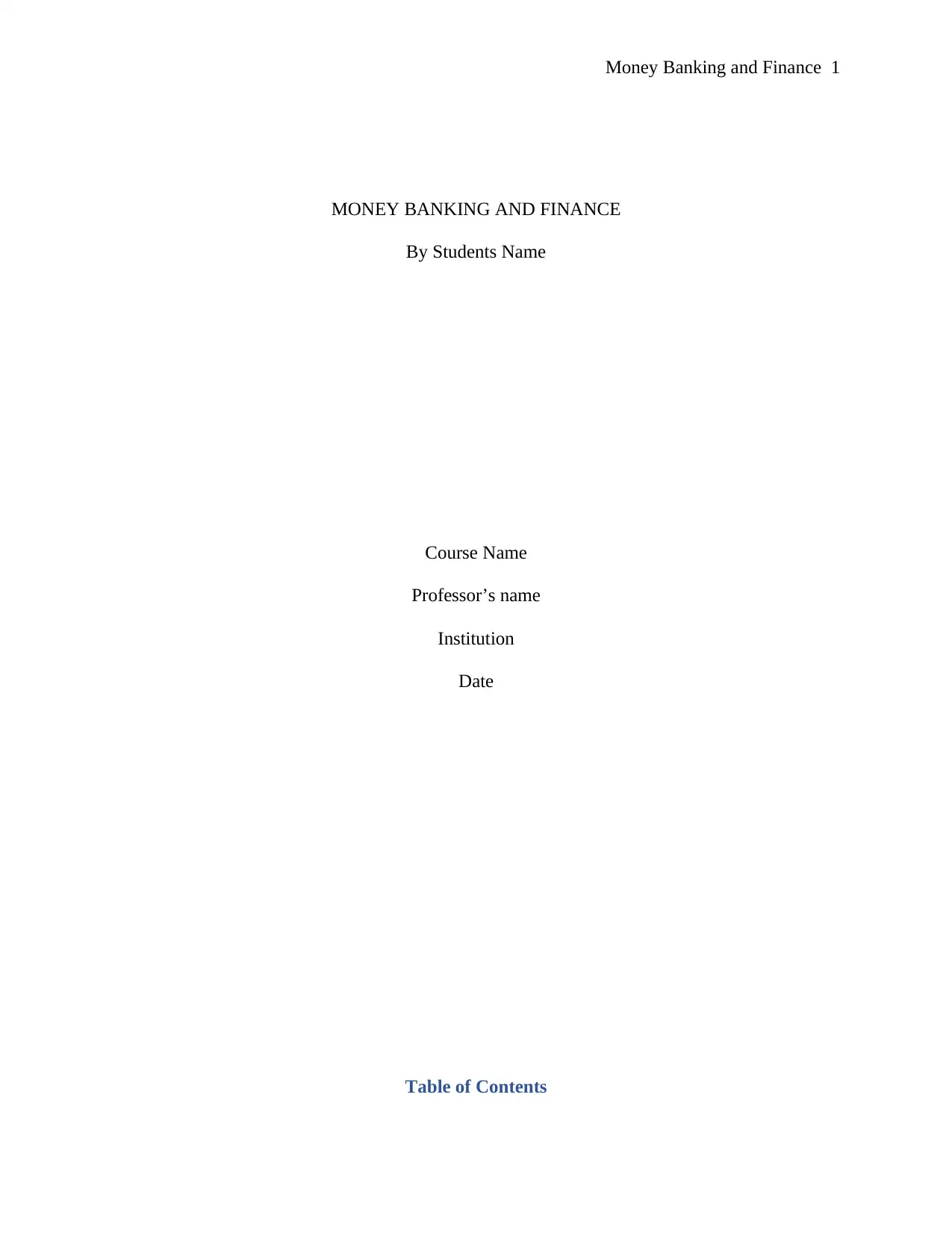
Money Banking and Finance 1
MONEY BANKING AND FINANCE
By Students Name
Course Name
Professor’s name
Institution
Date
Table of Contents
MONEY BANKING AND FINANCE
By Students Name
Course Name
Professor’s name
Institution
Date
Table of Contents
Paraphrase This Document
Need a fresh take? Get an instant paraphrase of this document with our AI Paraphraser
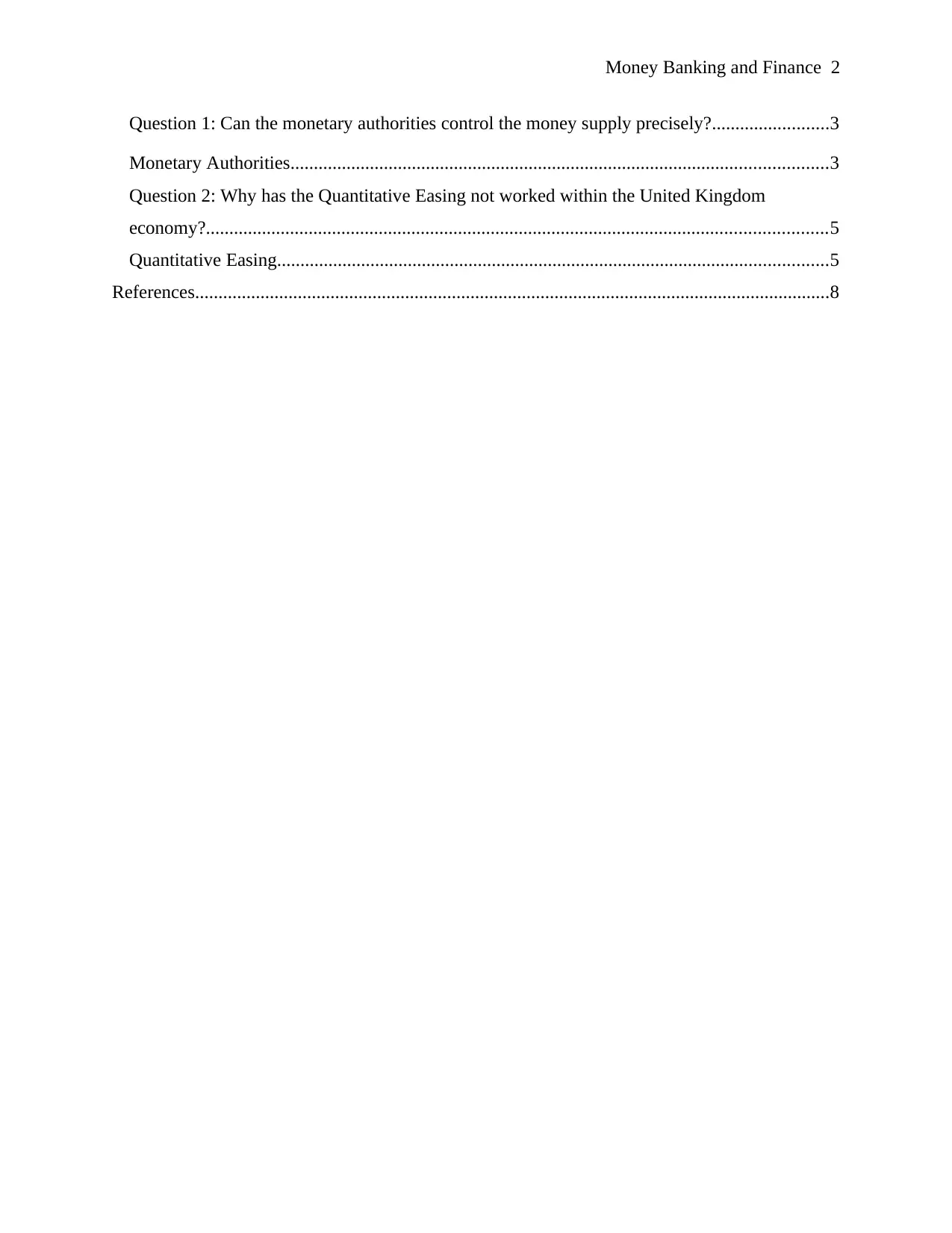
Money Banking and Finance 2
Question 1: Can the monetary authorities control the money supply precisely?.........................3
Monetary Authorities...................................................................................................................3
Question 2: Why has the Quantitative Easing not worked within the United Kingdom
economy?.....................................................................................................................................5
Quantitative Easing......................................................................................................................5
References........................................................................................................................................8
Question 1: Can the monetary authorities control the money supply precisely?.........................3
Monetary Authorities...................................................................................................................3
Question 2: Why has the Quantitative Easing not worked within the United Kingdom
economy?.....................................................................................................................................5
Quantitative Easing......................................................................................................................5
References........................................................................................................................................8
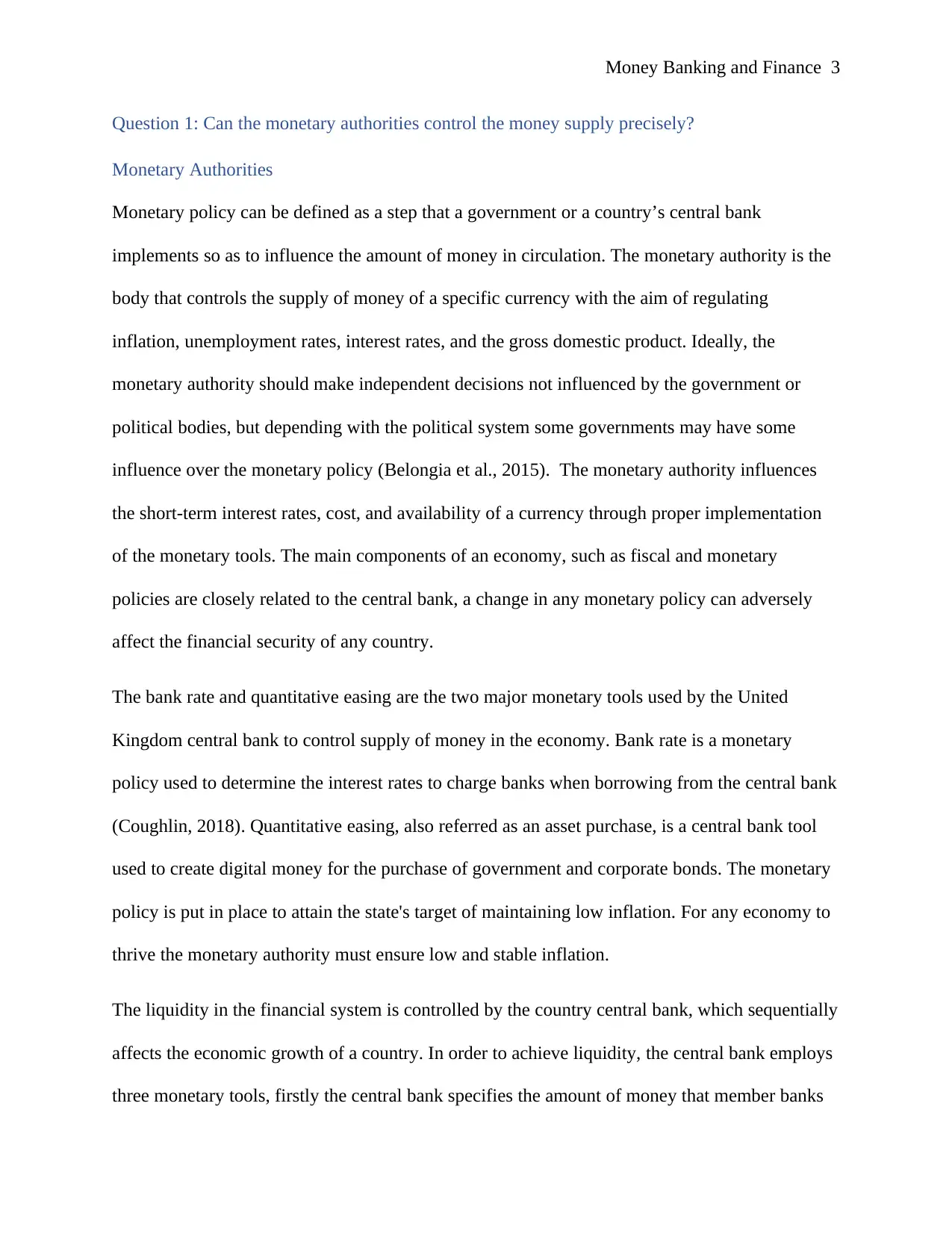
Money Banking and Finance 3
Question 1: Can the monetary authorities control the money supply precisely?
Monetary Authorities
Monetary policy can be defined as a step that a government or a country’s central bank
implements so as to influence the amount of money in circulation. The monetary authority is the
body that controls the supply of money of a specific currency with the aim of regulating
inflation, unemployment rates, interest rates, and the gross domestic product. Ideally, the
monetary authority should make independent decisions not influenced by the government or
political bodies, but depending with the political system some governments may have some
influence over the monetary policy (Belongia et al., 2015). The monetary authority influences
the short-term interest rates, cost, and availability of a currency through proper implementation
of the monetary tools. The main components of an economy, such as fiscal and monetary
policies are closely related to the central bank, a change in any monetary policy can adversely
affect the financial security of any country.
The bank rate and quantitative easing are the two major monetary tools used by the United
Kingdom central bank to control supply of money in the economy. Bank rate is a monetary
policy used to determine the interest rates to charge banks when borrowing from the central bank
(Coughlin, 2018). Quantitative easing, also referred as an asset purchase, is a central bank tool
used to create digital money for the purchase of government and corporate bonds. The monetary
policy is put in place to attain the state's target of maintaining low inflation. For any economy to
thrive the monetary authority must ensure low and stable inflation.
The liquidity in the financial system is controlled by the country central bank, which sequentially
affects the economic growth of a country. In order to achieve liquidity, the central bank employs
three monetary tools, firstly the central bank specifies the amount of money that member banks
Question 1: Can the monetary authorities control the money supply precisely?
Monetary Authorities
Monetary policy can be defined as a step that a government or a country’s central bank
implements so as to influence the amount of money in circulation. The monetary authority is the
body that controls the supply of money of a specific currency with the aim of regulating
inflation, unemployment rates, interest rates, and the gross domestic product. Ideally, the
monetary authority should make independent decisions not influenced by the government or
political bodies, but depending with the political system some governments may have some
influence over the monetary policy (Belongia et al., 2015). The monetary authority influences
the short-term interest rates, cost, and availability of a currency through proper implementation
of the monetary tools. The main components of an economy, such as fiscal and monetary
policies are closely related to the central bank, a change in any monetary policy can adversely
affect the financial security of any country.
The bank rate and quantitative easing are the two major monetary tools used by the United
Kingdom central bank to control supply of money in the economy. Bank rate is a monetary
policy used to determine the interest rates to charge banks when borrowing from the central bank
(Coughlin, 2018). Quantitative easing, also referred as an asset purchase, is a central bank tool
used to create digital money for the purchase of government and corporate bonds. The monetary
policy is put in place to attain the state's target of maintaining low inflation. For any economy to
thrive the monetary authority must ensure low and stable inflation.
The liquidity in the financial system is controlled by the country central bank, which sequentially
affects the economic growth of a country. In order to achieve liquidity, the central bank employs
three monetary tools, firstly the central bank specifies the amount of money that member banks
⊘ This is a preview!⊘
Do you want full access?
Subscribe today to unlock all pages.

Trusted by 1+ million students worldwide
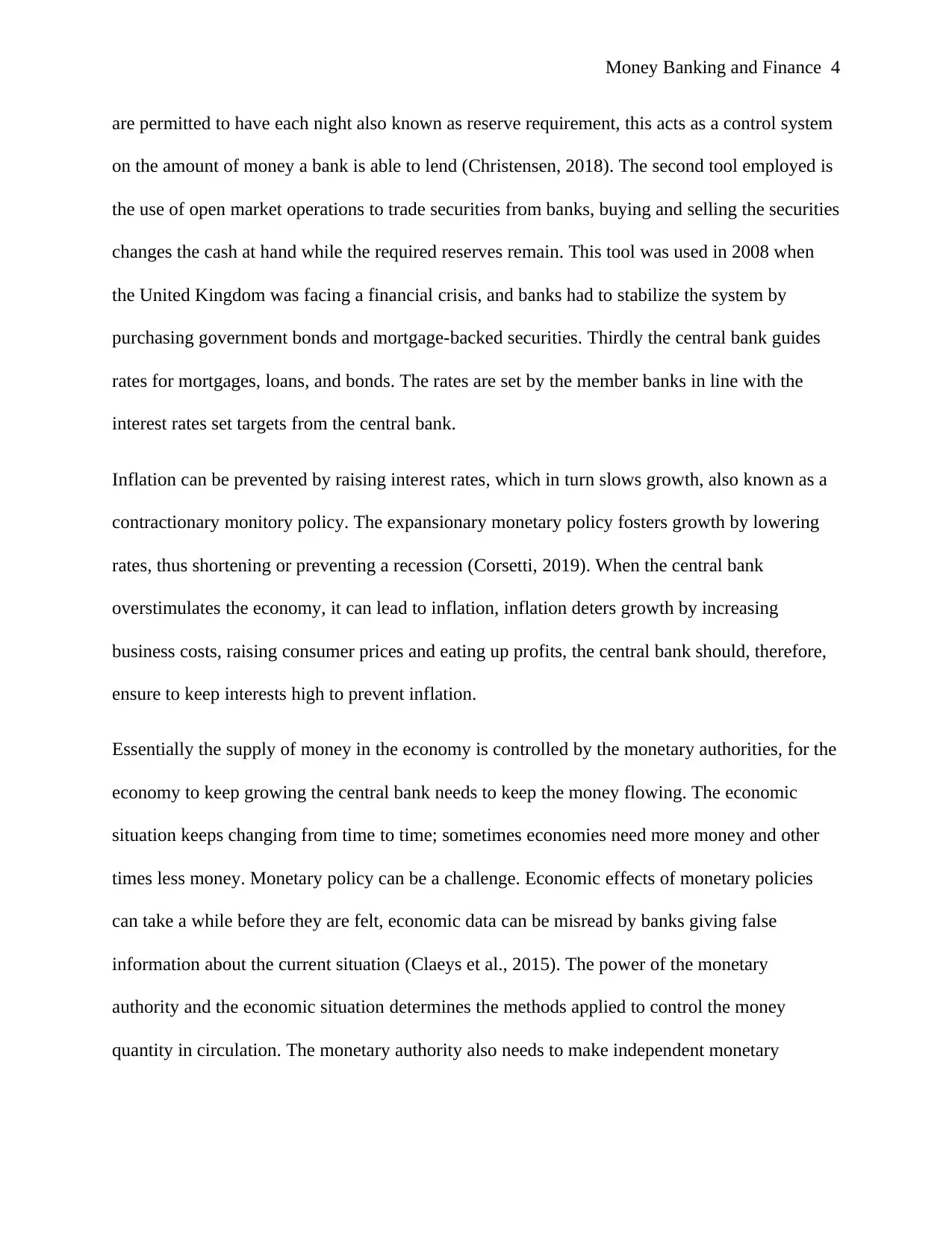
Money Banking and Finance 4
are permitted to have each night also known as reserve requirement, this acts as a control system
on the amount of money a bank is able to lend (Christensen, 2018). The second tool employed is
the use of open market operations to trade securities from banks, buying and selling the securities
changes the cash at hand while the required reserves remain. This tool was used in 2008 when
the United Kingdom was facing a financial crisis, and banks had to stabilize the system by
purchasing government bonds and mortgage-backed securities. Thirdly the central bank guides
rates for mortgages, loans, and bonds. The rates are set by the member banks in line with the
interest rates set targets from the central bank.
Inflation can be prevented by raising interest rates, which in turn slows growth, also known as a
contractionary monitory policy. The expansionary monetary policy fosters growth by lowering
rates, thus shortening or preventing a recession (Corsetti, 2019). When the central bank
overstimulates the economy, it can lead to inflation, inflation deters growth by increasing
business costs, raising consumer prices and eating up profits, the central bank should, therefore,
ensure to keep interests high to prevent inflation.
Essentially the supply of money in the economy is controlled by the monetary authorities, for the
economy to keep growing the central bank needs to keep the money flowing. The economic
situation keeps changing from time to time; sometimes economies need more money and other
times less money. Monetary policy can be a challenge. Economic effects of monetary policies
can take a while before they are felt, economic data can be misread by banks giving false
information about the current situation (Claeys et al., 2015). The power of the monetary
authority and the economic situation determines the methods applied to control the money
quantity in circulation. The monetary authority also needs to make independent monetary
are permitted to have each night also known as reserve requirement, this acts as a control system
on the amount of money a bank is able to lend (Christensen, 2018). The second tool employed is
the use of open market operations to trade securities from banks, buying and selling the securities
changes the cash at hand while the required reserves remain. This tool was used in 2008 when
the United Kingdom was facing a financial crisis, and banks had to stabilize the system by
purchasing government bonds and mortgage-backed securities. Thirdly the central bank guides
rates for mortgages, loans, and bonds. The rates are set by the member banks in line with the
interest rates set targets from the central bank.
Inflation can be prevented by raising interest rates, which in turn slows growth, also known as a
contractionary monitory policy. The expansionary monetary policy fosters growth by lowering
rates, thus shortening or preventing a recession (Corsetti, 2019). When the central bank
overstimulates the economy, it can lead to inflation, inflation deters growth by increasing
business costs, raising consumer prices and eating up profits, the central bank should, therefore,
ensure to keep interests high to prevent inflation.
Essentially the supply of money in the economy is controlled by the monetary authorities, for the
economy to keep growing the central bank needs to keep the money flowing. The economic
situation keeps changing from time to time; sometimes economies need more money and other
times less money. Monetary policy can be a challenge. Economic effects of monetary policies
can take a while before they are felt, economic data can be misread by banks giving false
information about the current situation (Claeys et al., 2015). The power of the monetary
authority and the economic situation determines the methods applied to control the money
quantity in circulation. The monetary authority also needs to make independent monetary
Paraphrase This Document
Need a fresh take? Get an instant paraphrase of this document with our AI Paraphraser
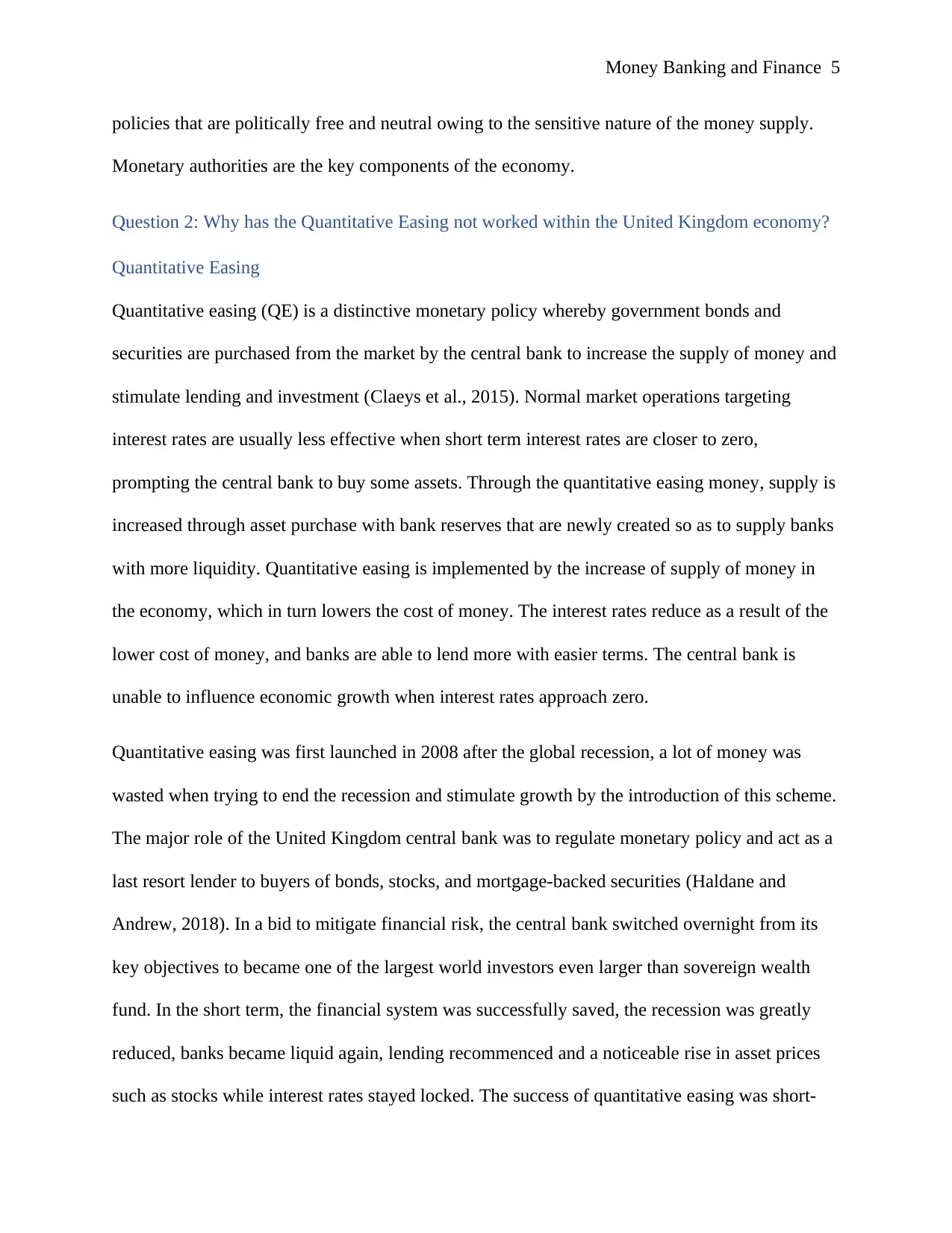
Money Banking and Finance 5
policies that are politically free and neutral owing to the sensitive nature of the money supply.
Monetary authorities are the key components of the economy.
Question 2: Why has the Quantitative Easing not worked within the United Kingdom economy?
Quantitative Easing
Quantitative easing (QE) is a distinctive monetary policy whereby government bonds and
securities are purchased from the market by the central bank to increase the supply of money and
stimulate lending and investment (Claeys et al., 2015). Normal market operations targeting
interest rates are usually less effective when short term interest rates are closer to zero,
prompting the central bank to buy some assets. Through the quantitative easing money, supply is
increased through asset purchase with bank reserves that are newly created so as to supply banks
with more liquidity. Quantitative easing is implemented by the increase of supply of money in
the economy, which in turn lowers the cost of money. The interest rates reduce as a result of the
lower cost of money, and banks are able to lend more with easier terms. The central bank is
unable to influence economic growth when interest rates approach zero.
Quantitative easing was first launched in 2008 after the global recession, a lot of money was
wasted when trying to end the recession and stimulate growth by the introduction of this scheme.
The major role of the United Kingdom central bank was to regulate monetary policy and act as a
last resort lender to buyers of bonds, stocks, and mortgage-backed securities (Haldane and
Andrew, 2018). In a bid to mitigate financial risk, the central bank switched overnight from its
key objectives to became one of the largest world investors even larger than sovereign wealth
fund. In the short term, the financial system was successfully saved, the recession was greatly
reduced, banks became liquid again, lending recommenced and a noticeable rise in asset prices
such as stocks while interest rates stayed locked. The success of quantitative easing was short-
policies that are politically free and neutral owing to the sensitive nature of the money supply.
Monetary authorities are the key components of the economy.
Question 2: Why has the Quantitative Easing not worked within the United Kingdom economy?
Quantitative Easing
Quantitative easing (QE) is a distinctive monetary policy whereby government bonds and
securities are purchased from the market by the central bank to increase the supply of money and
stimulate lending and investment (Claeys et al., 2015). Normal market operations targeting
interest rates are usually less effective when short term interest rates are closer to zero,
prompting the central bank to buy some assets. Through the quantitative easing money, supply is
increased through asset purchase with bank reserves that are newly created so as to supply banks
with more liquidity. Quantitative easing is implemented by the increase of supply of money in
the economy, which in turn lowers the cost of money. The interest rates reduce as a result of the
lower cost of money, and banks are able to lend more with easier terms. The central bank is
unable to influence economic growth when interest rates approach zero.
Quantitative easing was first launched in 2008 after the global recession, a lot of money was
wasted when trying to end the recession and stimulate growth by the introduction of this scheme.
The major role of the United Kingdom central bank was to regulate monetary policy and act as a
last resort lender to buyers of bonds, stocks, and mortgage-backed securities (Haldane and
Andrew, 2018). In a bid to mitigate financial risk, the central bank switched overnight from its
key objectives to became one of the largest world investors even larger than sovereign wealth
fund. In the short term, the financial system was successfully saved, the recession was greatly
reduced, banks became liquid again, lending recommenced and a noticeable rise in asset prices
such as stocks while interest rates stayed locked. The success of quantitative easing was short-
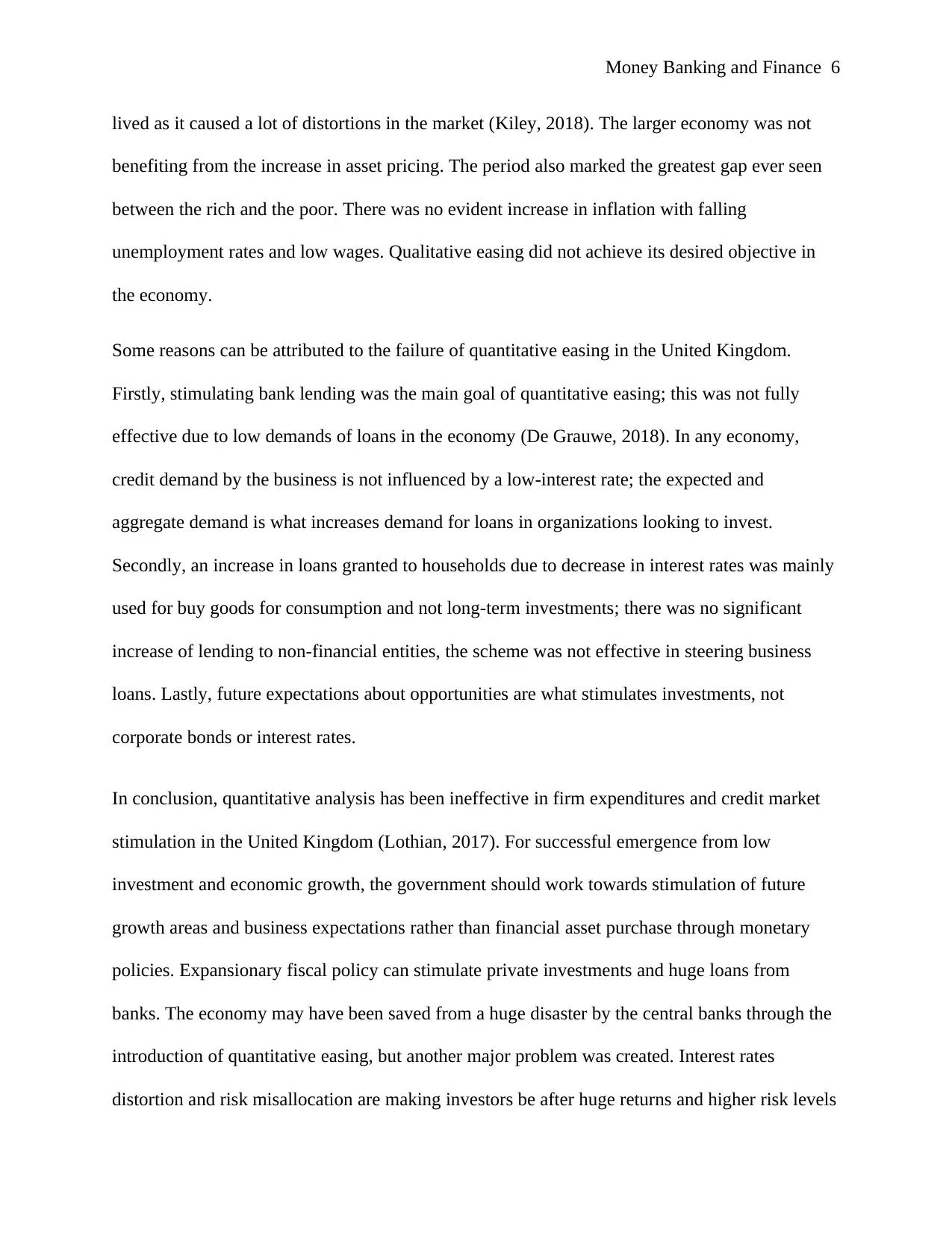
Money Banking and Finance 6
lived as it caused a lot of distortions in the market (Kiley, 2018). The larger economy was not
benefiting from the increase in asset pricing. The period also marked the greatest gap ever seen
between the rich and the poor. There was no evident increase in inflation with falling
unemployment rates and low wages. Qualitative easing did not achieve its desired objective in
the economy.
Some reasons can be attributed to the failure of quantitative easing in the United Kingdom.
Firstly, stimulating bank lending was the main goal of quantitative easing; this was not fully
effective due to low demands of loans in the economy (De Grauwe, 2018). In any economy,
credit demand by the business is not influenced by a low-interest rate; the expected and
aggregate demand is what increases demand for loans in organizations looking to invest.
Secondly, an increase in loans granted to households due to decrease in interest rates was mainly
used for buy goods for consumption and not long-term investments; there was no significant
increase of lending to non-financial entities, the scheme was not effective in steering business
loans. Lastly, future expectations about opportunities are what stimulates investments, not
corporate bonds or interest rates.
In conclusion, quantitative analysis has been ineffective in firm expenditures and credit market
stimulation in the United Kingdom (Lothian, 2017). For successful emergence from low
investment and economic growth, the government should work towards stimulation of future
growth areas and business expectations rather than financial asset purchase through monetary
policies. Expansionary fiscal policy can stimulate private investments and huge loans from
banks. The economy may have been saved from a huge disaster by the central banks through the
introduction of quantitative easing, but another major problem was created. Interest rates
distortion and risk misallocation are making investors be after huge returns and higher risk levels
lived as it caused a lot of distortions in the market (Kiley, 2018). The larger economy was not
benefiting from the increase in asset pricing. The period also marked the greatest gap ever seen
between the rich and the poor. There was no evident increase in inflation with falling
unemployment rates and low wages. Qualitative easing did not achieve its desired objective in
the economy.
Some reasons can be attributed to the failure of quantitative easing in the United Kingdom.
Firstly, stimulating bank lending was the main goal of quantitative easing; this was not fully
effective due to low demands of loans in the economy (De Grauwe, 2018). In any economy,
credit demand by the business is not influenced by a low-interest rate; the expected and
aggregate demand is what increases demand for loans in organizations looking to invest.
Secondly, an increase in loans granted to households due to decrease in interest rates was mainly
used for buy goods for consumption and not long-term investments; there was no significant
increase of lending to non-financial entities, the scheme was not effective in steering business
loans. Lastly, future expectations about opportunities are what stimulates investments, not
corporate bonds or interest rates.
In conclusion, quantitative analysis has been ineffective in firm expenditures and credit market
stimulation in the United Kingdom (Lothian, 2017). For successful emergence from low
investment and economic growth, the government should work towards stimulation of future
growth areas and business expectations rather than financial asset purchase through monetary
policies. Expansionary fiscal policy can stimulate private investments and huge loans from
banks. The economy may have been saved from a huge disaster by the central banks through the
introduction of quantitative easing, but another major problem was created. Interest rates
distortion and risk misallocation are making investors be after huge returns and higher risk levels
⊘ This is a preview!⊘
Do you want full access?
Subscribe today to unlock all pages.

Trusted by 1+ million students worldwide
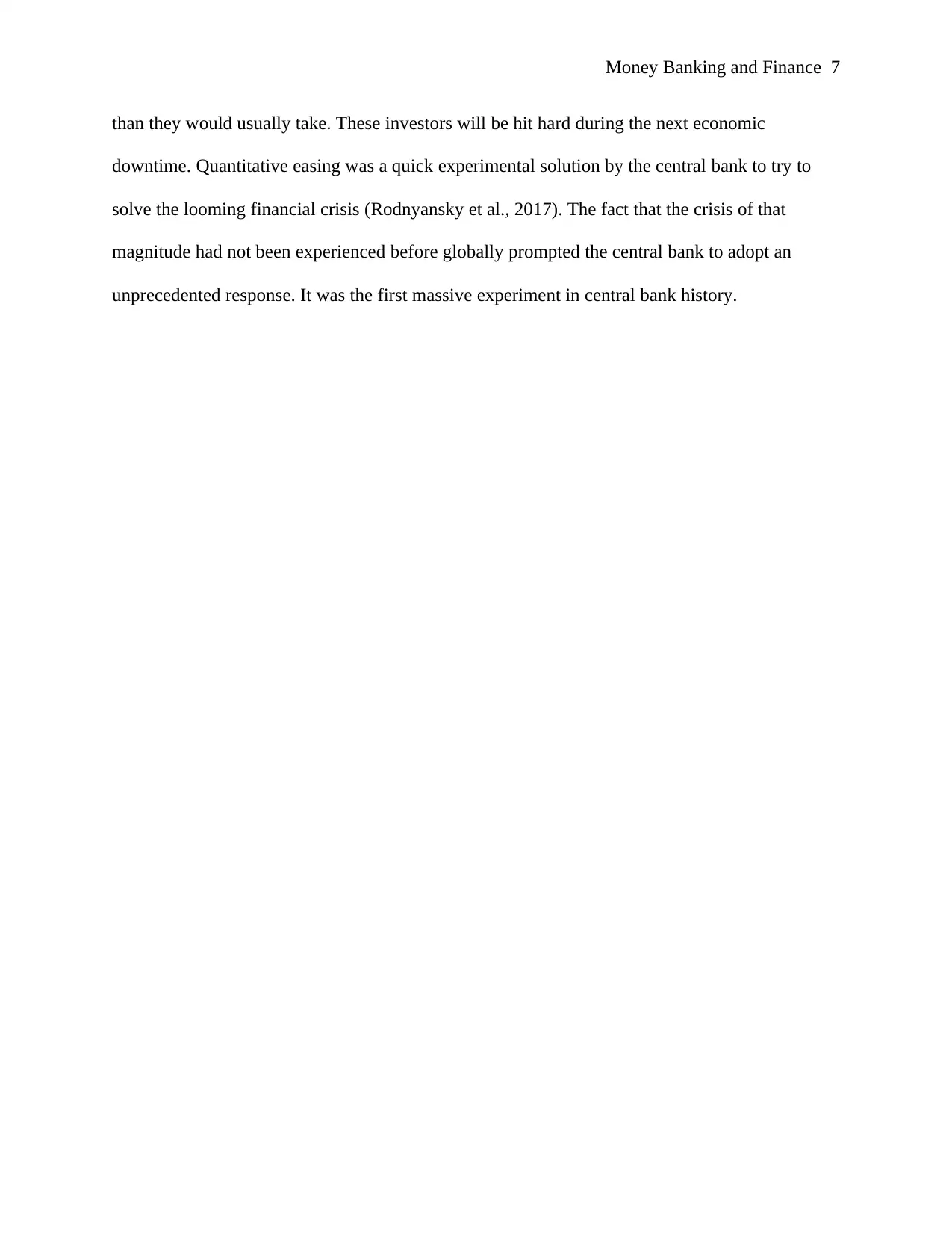
Money Banking and Finance 7
than they would usually take. These investors will be hit hard during the next economic
downtime. Quantitative easing was a quick experimental solution by the central bank to try to
solve the looming financial crisis (Rodnyansky et al., 2017). The fact that the crisis of that
magnitude had not been experienced before globally prompted the central bank to adopt an
unprecedented response. It was the first massive experiment in central bank history.
than they would usually take. These investors will be hit hard during the next economic
downtime. Quantitative easing was a quick experimental solution by the central bank to try to
solve the looming financial crisis (Rodnyansky et al., 2017). The fact that the crisis of that
magnitude had not been experienced before globally prompted the central bank to adopt an
unprecedented response. It was the first massive experiment in central bank history.
Paraphrase This Document
Need a fresh take? Get an instant paraphrase of this document with our AI Paraphraser
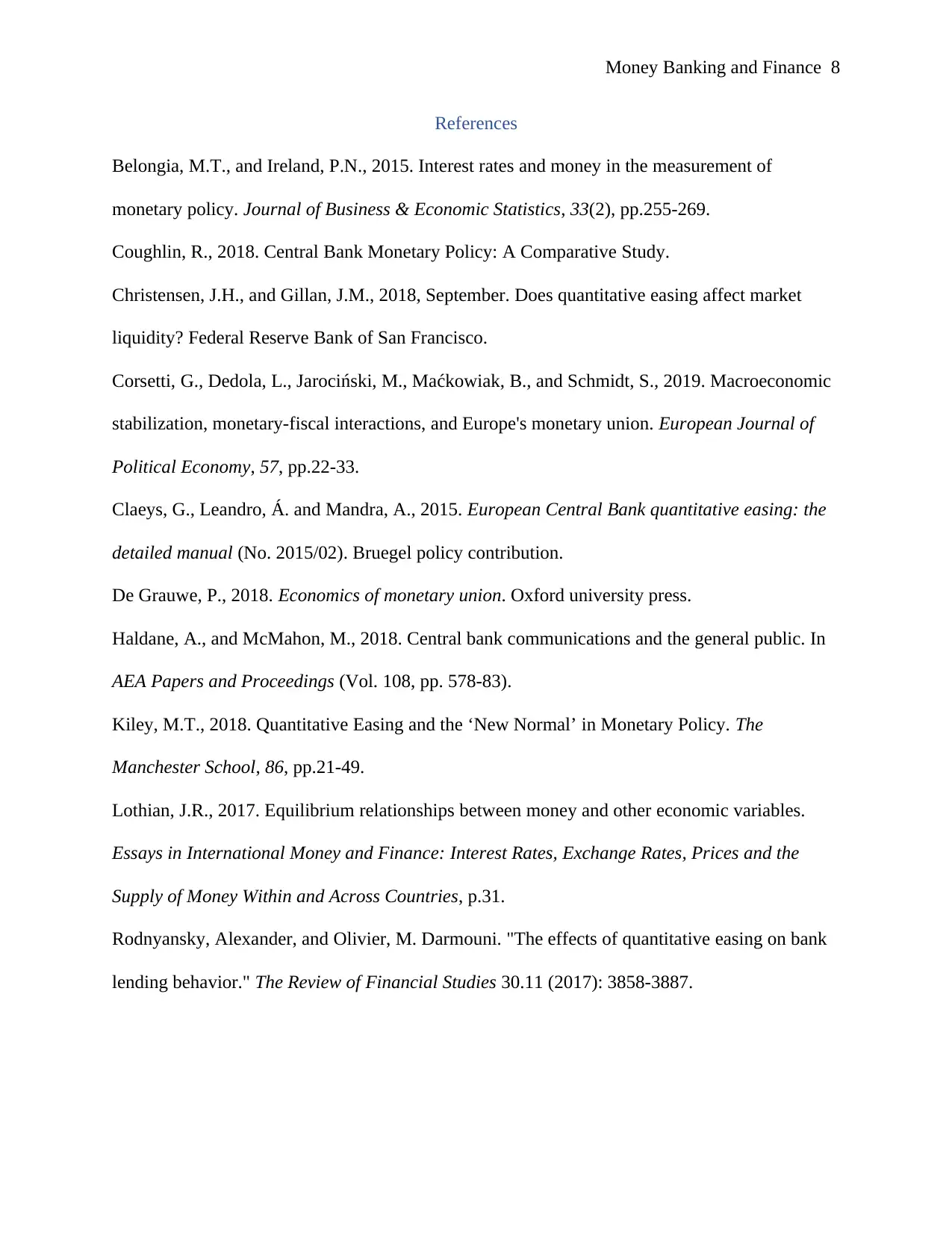
Money Banking and Finance 8
References
Belongia, M.T., and Ireland, P.N., 2015. Interest rates and money in the measurement of
monetary policy. Journal of Business & Economic Statistics, 33(2), pp.255-269.
Coughlin, R., 2018. Central Bank Monetary Policy: A Comparative Study.
Christensen, J.H., and Gillan, J.M., 2018, September. Does quantitative easing affect market
liquidity? Federal Reserve Bank of San Francisco.
Corsetti, G., Dedola, L., Jarociński, M., Maćkowiak, B., and Schmidt, S., 2019. Macroeconomic
stabilization, monetary-fiscal interactions, and Europe's monetary union. European Journal of
Political Economy, 57, pp.22-33.
Claeys, G., Leandro, Á. and Mandra, A., 2015. European Central Bank quantitative easing: the
detailed manual (No. 2015/02). Bruegel policy contribution.
De Grauwe, P., 2018. Economics of monetary union. Oxford university press.
Haldane, A., and McMahon, M., 2018. Central bank communications and the general public. In
AEA Papers and Proceedings (Vol. 108, pp. 578-83).
Kiley, M.T., 2018. Quantitative Easing and the ‘New Normal’ in Monetary Policy. The
Manchester School, 86, pp.21-49.
Lothian, J.R., 2017. Equilibrium relationships between money and other economic variables.
Essays in International Money and Finance: Interest Rates, Exchange Rates, Prices and the
Supply of Money Within and Across Countries, p.31.
Rodnyansky, Alexander, and Olivier, M. Darmouni. "The effects of quantitative easing on bank
lending behavior." The Review of Financial Studies 30.11 (2017): 3858-3887.
References
Belongia, M.T., and Ireland, P.N., 2015. Interest rates and money in the measurement of
monetary policy. Journal of Business & Economic Statistics, 33(2), pp.255-269.
Coughlin, R., 2018. Central Bank Monetary Policy: A Comparative Study.
Christensen, J.H., and Gillan, J.M., 2018, September. Does quantitative easing affect market
liquidity? Federal Reserve Bank of San Francisco.
Corsetti, G., Dedola, L., Jarociński, M., Maćkowiak, B., and Schmidt, S., 2019. Macroeconomic
stabilization, monetary-fiscal interactions, and Europe's monetary union. European Journal of
Political Economy, 57, pp.22-33.
Claeys, G., Leandro, Á. and Mandra, A., 2015. European Central Bank quantitative easing: the
detailed manual (No. 2015/02). Bruegel policy contribution.
De Grauwe, P., 2018. Economics of monetary union. Oxford university press.
Haldane, A., and McMahon, M., 2018. Central bank communications and the general public. In
AEA Papers and Proceedings (Vol. 108, pp. 578-83).
Kiley, M.T., 2018. Quantitative Easing and the ‘New Normal’ in Monetary Policy. The
Manchester School, 86, pp.21-49.
Lothian, J.R., 2017. Equilibrium relationships between money and other economic variables.
Essays in International Money and Finance: Interest Rates, Exchange Rates, Prices and the
Supply of Money Within and Across Countries, p.31.
Rodnyansky, Alexander, and Olivier, M. Darmouni. "The effects of quantitative easing on bank
lending behavior." The Review of Financial Studies 30.11 (2017): 3858-3887.
1 out of 8
Related Documents
Your All-in-One AI-Powered Toolkit for Academic Success.
+13062052269
info@desklib.com
Available 24*7 on WhatsApp / Email
![[object Object]](/_next/static/media/star-bottom.7253800d.svg)
Unlock your academic potential
Copyright © 2020–2025 A2Z Services. All Rights Reserved. Developed and managed by ZUCOL.





